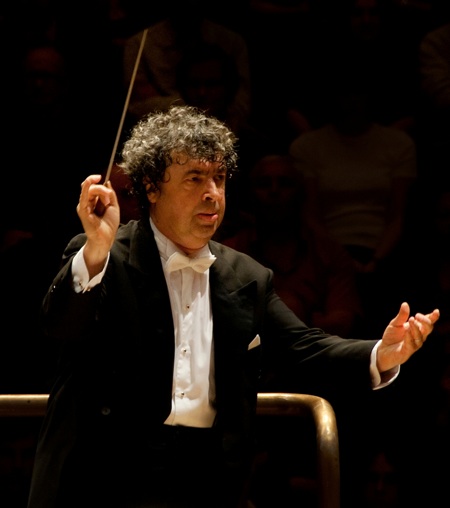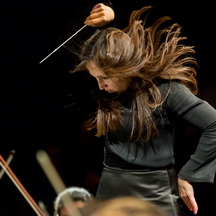A passion for life…
Last weekend, Semyon Bychkov completed his collaboration with the SF Symphony in style. After a first week program that included famed violinist Pinchas Zukerman in Bruch’s Violin Concerto and Tchaikovsky’s elegant Symphony No. 5, they essayed Shostakovich’s blockbuster Symphony No. 11, the “1905,” to high acclaim. Schubert’s marvelous two-movement “Unfinished” symphony opened the program.
Schubert, a cherubic baby-faced prodigy who wrote prodigiously and died young, penned the Unfinished symphony in 1822 at the age of 25, following six completed symphonies and a host of other works. He died six years later at the age of 31. Though he was youthful, that fragmentary symphony was a work of mature polish and depth, with lyrical motifs that have resonated through the ages, matched with dark masses of sound and a power that rivals Beethoven’s.
So was it truly unfinished? Clearly, by Schubert’s standard: his sketches for a scherzo movement tend to support that. But there is a quality of wholeness to the work that resists any further motion. Many composers have attempted to add to the two movements, but Schubert himself was stymied—and maybe that is for the best. After all, today’s standards are wider and looser: no longer do we posit a thesis and antithesis, and then resolve them in a finale’s crashing synthesis, but a single movement can engender and impel its own questions and solutions. And other composers posit only questions, and perhaps those are answers.
 For this piece Bychkov conducted a reduced orchestra without his podium, crowding in among his strings. Basses thrummed the air with an intro, and I remembered why live music is so exciting—there is no home woofer large enough to do justice to that full lower spectrum of sound. Then the violins entered, clever sixteenths that presaged modern minimalists while also restating the theme. Finally, the cool clarity of a clarinet soaring with a melody that is now famous. And all this in the first 20 bars! Over this, Schubert’s extremes of thunder and intimacy helped propel German Romanticism into Brahms’ capable hands.
For this piece Bychkov conducted a reduced orchestra without his podium, crowding in among his strings. Basses thrummed the air with an intro, and I remembered why live music is so exciting—there is no home woofer large enough to do justice to that full lower spectrum of sound. Then the violins entered, clever sixteenths that presaged modern minimalists while also restating the theme. Finally, the cool clarity of a clarinet soaring with a melody that is now famous. And all this in the first 20 bars! Over this, Schubert’s extremes of thunder and intimacy helped propel German Romanticism into Brahms’ capable hands.
There is a lot here of Beethoven, Schubert’s idol: the stirring nobility of Beethoven’s middle “pomp” period and the alternation of sturm und drang with a lean lyricism, a deceptively fragile beauty. And the way he used long-held French horn notes to finish one key and begin another, a pin-turn that Beethoven pioneered. Schubert was one of the pallbearers at Beethoven’s funeral—although he himself died a single year later, and is buried beside him.
The second movement is sweetly tragic, phrases in violin and flute that make one shiver with their beauty and sense of the inevitable. And then they darken into minor—it is a doomed passion, and another high point of the repertoire.
…and a passion for justice.
They brought in a podium and fifty more musicians, and we were ready for the main course! From the high teasing violin tremolos to a lone trumpet muted into silvered distance, this work was as darkly evocative as the Schubert. But it was clearly Shostakovich, leavening chromaticism and fragments of stirring revolutionary songs with the modal scales of the Orthodox Russian Church, then pitting that against the simple—and chilling—trumpet reveilles of soldiers.
It was starlight and night chill, with harp and high strings against the deepest cello and bass notes, hollow in the center. It was also cruelly stark, leaving us with bloodstains on the snow.
This work is big in every way. Plexiglas partitions between the percussion and the rear strings, and the earplugs worn by musicians, should have clued us into Shostakovich’s vision of the horror of war. Written ostensibly for the 1905 victims of a peaceful demonstration turned to rout, this was also a memorial to the crushing of Hungary in October of 1956, when Russia sent troops and tanks in to silence an uprising against the puppet regime, after that government machine-gunned down hundreds of protesters. Shostakovich, whose father survived the 1905 demonstration, risked his life to condemn the Russian government, even in this coded fashion. Written one year later, in 1957, Symphony No. 11 is a rebuke to tyranny. His use of prison songs and revolutionary tunes are particularly powerful for Russians, who grew up hearing them.
The emotional strain of the production was evident afterwards. Bychkov took the time to shake hands with each member of the inner strings, and then bowed to the orchestra with hand to heart. He was clearly moved, and his musicians, as obviously, gave him their love. The audience was on its feet, bringing him back three times before letting him go.
One hopes he will return soon and often.
—Adam Broner
Photo of Semyon Bychkov; photo by Rob Brimson.
